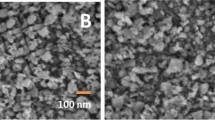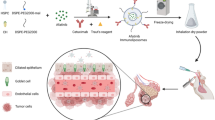Abstract
Purpose
To determine aerosol administration capability and therapeutic efficacy of the new formulation of hyaluronan cisplatin conjugates, HylaPlat™ (HA-Pt), for lung cancer treatment.
Methods
In vitro formulation stability test, 2D and 3D spheroid cell culture and in vivo efficacy studies using mouse orthotopic allograft models were conducted.
Results
The HA-Pt effectively attenuated cell growth in 2D and 3D cultures with IC50 of 2.62 and 5.36 μM, respectively, which were comparable to those with unconjugated control cisplatin-dependent growth inhibition (IC50 1.64 and 4.63 μM, respectively). A single dose of either 7.5 or 15 mg/kg HA-Pt (cisplatin equivalent) by intratracheal aerosol spray 7 days after Lewis lung carcinoma (LLC) cell inoculation markedly inhibited growth of LLC allografts in mouse lungs and resulted in a 90 or 94% reduction of tumor nodule numbers, respectively, as compared to those from the PBS control. Cancer stem cells and cisplatin resistant cells marker, CD44 expression decreased in the tumor nodules of the HA-Pt but not in those of cisplatin treated groups.
Conclusions
The current study suggests that an intratracheal aerosol administration of the HA-Pt nanoparticles offers an effective strategy for lung cancer treatment and this treatment may induce only limited cisplatin resistance.





Similar content being viewed by others
Abbreviations
- 2D:
-
Two dimensional
- 3D:
-
Three dimensional
- cfu:
-
Colony forming units
- EU:
-
Endotoxin units
- FBS:
-
Fetal bovine serum
- HA:
-
Hyaluronan
- HAdase:
-
Hyaluronidase
- HA-Pt:
-
Hyaluronan-cisplatin nanoconjugate
- IT:
-
Intratracheal
- LLC:
-
Lewis Lung carcinoma
- SEC:
-
Size exclusion chromatography
- Tg :
-
Glass transition temperature
- TUNEL:
-
Terminal deoxynucleotidyl transferase dUTP nick end labeling
- USP:
-
US Pharmacopeia
References
Howlader N, Noone A, Krapcho M, Garshell J, Miller D, Altekruse S, Kosary C, Yu M, Ruhl J, Tatalovich Z, Mariotto A, Lewis D, Chen H, Feuer E, Cronin Ke. SEER Cancer Statistics Review, 1975-2012, National Cancer Institute. Bethesda, MD, http://seer.cancer.gov/csr/1975_2012/, based on November 2014 SEER data submission, posted to the SEER web site, 2015.
Siegel RL, Miller KD, Jemal A. Cancer statistics, 2015. CA Cancer J Clin. 2015;65(1):5–29.
Blanco E, Hsiao A, Mann AP, Landry MG, Meric-Bernstam F, Ferrari M. Nanomedicine in cancer therapy: innovative trends and prospects. Cancer Sci. 2011;102(7):1247–52.
Chow EK, Ho D. Cancer nanomedicine: from drug delivery to imaging. Sci Transl Med. 2013;5(216):216rv214.
Ediriwickrema A, Saltzman WM. Nanotherapy for cancer: targeting and multifunctionality in the future of cancer therapies. ACS Biomater Sci Eng. 2015;1(2):64–78.
Ryan SM, Brayden DJ. Progress in the delivery of nanoparticle constructs: towards clinical translation. Curr Opin Pharmacol. 2014;18:120–8.
Pisters KM, Evans WK, Azzoli CG, Kris MG, Smith CA, Desch CE, et al. Cancer Care Ontario and American Society of Clinical Oncology adjuvant chemotherapy and adjuvant radiation therapy for stages I-IIIA resectable non small-cell lung cancer guideline. J Clin Oncol. 2007;25(34):5506–18.
Rajeswaran A, Trojan A, Burnand B, Giannelli M. Efficacy and side effects of cisplatin- and carboplatin-based doublet chemotherapeutic regimens versus non-platinum-based doublet chemotherapeutic regimens as first line treatment of metastatic non-small cell lung carcinoma: a systematic review of randomized controlled trials. Lung Cancer. 2008;59(1):1–11.
Reed E, Chabner B. Platinum analoges. Phildelphia: Lippincott Williams & Wilkins; 2011.
de Castria TB, da Silva EM, Gois AF, Riera R. Cisplatin versus carboplatin in combination with third-generation drugs for advanced non-small cell lung cancer. Cochrane Database Syst Rev. 2013;8, CD009256.
Winton T, Livingston R, Johnson D, Rigas J, Johnston M, Butts C, et al. Vinorelbine plus cisplatin vs. observation in resected non-small-cell lung cancer. N Engl J Med. 2005;352(25):2589–97.
Kelly K, Crowley J, Bunn Jr PA, Presant CA, Grevstad PK, Moinpour CM, et al. Randomized phase III trial of paclitaxel plus carboplatin versus vinorelbine plus cisplatin in the treatment of patients with advanced non--small-cell lung cancer: a Southwest Oncology Group trial. J Clin Oncol. 2001;19(13):3210–8.
Casagrande N, Celegato M, Borghese C, Mongiat M, Colombatti A, Aldinucci D. Preclinical activity of the liposomal cisplatin lipoplatin in ovarian cancer. Clin Cancer Res. 2014;20(21):5496–506.
Stathopoulos GP. Liposomal cisplatin: a new cisplatin formulation. Anticancer Drugs. 2010;21(8):732–6.
Go RS, Adjei AA. Review of the comparative pharmacology and clinical activity of cisplatin and carboplatin. J Clin Oncol. 1999;17(1):409–22.
Cai S, Xie Y, Bagby TR, Cohen MS, Forrest ML. Intralymphatic chemotherapy using a hyaluronan-cisplatin conjugate. J Surg Res. 2008;147(2):247–52.
Cai S, Xie Y, Davies NM, Cohen MS, Forrest ML. Carrier-based intralymphatic cisplatin chemotherapy for the treatment of metastatic squamous cell carcinoma of the head & neck. Ther Deliv. 2010;1(2):237–45.
Cohen SM, Rockefeller N, Mukerji R, Durham D, Forrest ML, Cai S, et al. Efficacy and toxicity of peritumoral delivery of nanoconjugated cisplatin in an in vivo murine model of head and neck squamous cell carcinoma. JAMA Otolaryngol Head Neck Surg. 2013;139(4):382–7.
Cohen MS, Cai S, Xie Y, Forrest ML. A novel intralymphatic nanocarrier delivery system for cisplatin therapy in breast cancer with improved tumor efficacy and lower systemic toxicity in vivo. Am J Surg. 2009;198(6):781–6.
Yang Q, Aires DJ, Cai S, Fraga GR, Zhang D, Li CZ, et al. In vivo efficacy of nano hyaluronan-conjugated cisplatin for treatment of murine melanoma. J Drugs Dermatol: JDD. 2014;13(3):283–7.
Venable R, Worley D, Gustafson D, Hansen R, Ehrhart E, Cai S, et al. Hyaluronan cisplatin conjugate in five dogs with soft tissue sarcomas. Am J Vet Res. 2012;73(12):1969–76.
Brown TJ. The development of hyaluronan as a drug transporter and excipient for chemotherapeutic drugs. Curr Pharm Biotechnol. 2008;9(4):253–60.
Cai S, Alhowyan AA, Yang Q, Forrest WC, Shnayder Y, Forrest ML. Cellular uptake and internalization of hyaluronan-based doxorubicin and cisplatin conjugates. J Drug Target. 2014;22(7):648–57.
Maiolino S, Moret F, Conte C, Fraix A, Tirino P, Ungaro F, et al. Hyaluronan-decorated polymer nanoparticles targeting the CD44 receptor for the combined photo/chemo-therapy of cancer. Nanoscale. 2015;7(13):5643–53.
Ko YH, Won HS, Jeon EK, Hong SH, Roh SY, Hong YS, et al. Prognostic significance of CD44s expression in resected non-small cell lung cancer. BMC Cancer. 2011;11:340.
Leung EL, Fiscus RR, Tung JW, Tin VP, Cheng LC, Sihoe AD, et al. Non-small cell lung cancer cells expressing CD44 are enriched for stem cell-like properties. PLoS One. 2010;5(11), e14062.
Orian-Rousseau V. CD44, a therapeutic target for metastasising tumours. Eur J Cancer. 2010;46(7):1271–7.
Petrey AC, de la Motte CA. Hyaluronan, a crucial regulator of inflammation. Front Immunol. 2014;5:101.
Zoller M. CD44: can a cancer-initiating cell profit from an abundantly expressed molecule? Nat Rev Cancer. 2011;11(4):254–67.
Cai S, Xie Y, Davies NM, Cohen MS, Forrest ML. Pharmacokinetics and disposition of a localized lymphatic polymeric hyaluronan conjugate of cisplatin in rodents. J Pharm Sci. 2010;99(6):2664–71.
Venable ROWD, Gustafson DL, Hansen RJ, Ehrhart III EJ, Cai S, Cohen MS, et al. Effects of intratumoral administration of a hyaluronan-cisplatin nanoconjugate to five dogs with soft tissue sarcomas. Am J Vet Res. 2012;73(12):1969–76.
Cai S, Zhang T, Forrest WC, Yang Q, Groer C, Mohr E, Aires DJ, Axiak-Bechtel SM, Flesner BK, Henry CJ, Selting KA, Tate D, Swarz JA, Bryan JN, Forrest ML. Phase I/II Clinical Trial of Hyaluronan-Cisplatin Nanoconjugate for the Treatment of Spontaneous Canine Cancers. American Journal of Veterinary Research. 2015;Accepted.
Pickel L, Matsuzuka T, Doi C, Ayuzawa R, Maurya DK, Xie SX, et al. Overexpression of angiotensin II type 2 receptor gene induces cell death in lung adenocarcinoma cells. Cancer Biol Ther. 2010;9(4):277–85.
Friedrich J, Seidel C, Ebner R, Kunz-Schughart LA. Spheroid-based drug screen: considerations and practical approach. Nat Protoc. 2009;4(3):309–24.
Matsuzuka T, Rachakatla RS, Doi C, Maurya DK, Ohta N, Kawabata A, et al. Human umbilical cord matrix-derived stem cells expressing interferon-beta gene significantly attenuate bronchioloalveolar carcinoma xenografts in SCID mice. Lung Cancer. 2010;70(1):28–36.
Lewis RJ, Sax NI. Sax's dangerous properties of industrial materials. New York: Van Nostrand Reinhold; 1996.
Xie Y, Aillon KL, Cai S, Christian JM, Davies NM, Berkland CJ, et al. Pulmonary delivery of cisplatin-hyaluronan conjugates via endotracheal instillation for the treatment of lung cancer. Int J Pharm. 2010;392(1-2):156–63.
Cohen SM, Mukerji R, Cai S, Damjanov I, Forrest ML, Cohen MS. Subcutaneous delivery of nanoconjugated doxorubicin and cisplatin for locally advanced breast cancer demonstrates improved efficacy and decreased toxicity at lower doses than standard systemic combination therapy in vivo. Am J Surg. 2011;202(6):646–52. discussion 652-643.
Al-Hajj M, Wicha MS, Benito-Hernandez A, Morrison SJ, Clarke MF. Prospective identification of tumorigenic breast cancer cells. Proc Natl Acad Sci U S A. 2003;100(7):3983–8.
Patrawala L, Calhoun T, Schneider-Broussard R, Li H, Bhatia B, Tang S, et al. Highly purified CD44+ prostate cancer cells from xenograft human tumors are enriched in tumorigenic and metastatic progenitor cells. Oncogene. 2006;25(12):1696–708.
Liu J, Xiao Z, Wong SK, Tin VP, Ho KY, Wang J, et al. Lung cancer tumorigenicity and drug resistance are maintained through ALDH(hi)CD44(hi) tumor initiating cells. Oncotarget. 2013;4(10):1698–711.
Torre C, Wang SJ, Xia W, Bourguignon LY. Reduction of hyaluronan-CD44-mediated growth, migration, and cisplatin resistance in head and neck cancer due to inhibition of Rho kinase and PI-3 kinase signaling. Arch Otolaryngol Head Neck Surg. 2010;136(5):493–501.
Yoon C, Park do J, Schmidt B, Thomas NJ, Lee HJ, Kim TS, et al. CD44 expression denotes a subpopulation of gastric cancer cells in which Hedgehog signaling promotes chemotherapy resistance. Clin Cancer Res. 2014;20(15):3974–88.
Luo Z, Wu RR, Lv L, Li P, Zhang LY, Hao QL, et al. Prognostic value of CD44 expression in non-small cell lung cancer: a systematic review. Int J Clin Exp Pathol. 2014;7(7):3632–46.
Matsubara Y, Katoh S, Taniguchii H, Oka M, Kadota J, Kohno S. Expression of CD44 variants in lung cancer and its relationship to hyaluronan binding. J Int Med Res. 2000;28(2):78–90.
Quan YH, Kim B, Park JH, Choi Y, Choi YH, Kim HK. Highly sensitive and selective anticancer effect by conjugated HA-cisplatin in non-small cell lung cancer overexpressed with CD44. Exp Lung Res. 2014;40(10):475–84.
Wittgen BP, Kunst PW, van der Born K, van Wijk AW, Perkins W, Pilkiewicz FG, et al. Phase I study of aerosolized SLIT cisplatin in the treatment of patients with carcinoma of the lung. Clin Cancer Res. 2007;13(8):2414–21.
ACKNOWLEDGMENTS AND DISCLOSURES
This work was also supported in part by Kansas State University Johnson Cancer Research Center (MT), Kansas Bioscience Authority Research grant (MLF) and NIH grant 1R01CA173292 (MLF).
We are grateful to Dr. Raelene Wouda (Department of Clinical Science, Kansas State University) for constructive comments during the preparation of the manuscript. We also thank Mr. Joel Sannemann (Department of Anatomy and Physiology, Kansas State University) for his technical support on the confocal microscope.
M.L. Forrest, W.C. Forrest, S. Cai and T. Zhang are employees and/or have ownership interest in HylaPharm, which has licensed HylaPlat technologies from the University of Kansas. No potential conflicts of interest were disclosed by the other authors.
Author information
Authors and Affiliations
Corresponding author
Additional information
Susumu Ishiguro and Shuang Cai contributed equally to this work.
Electronic supplementary material
Below is the link to the electronic supplementary material.
ESM 1
(DOCX 5031 kb)
Rights and permissions
About this article
Cite this article
Ishiguro, S., Cai, S., Uppalapati, D. et al. Intratracheal Administration of Hyaluronan-Cisplatin Conjugate Nanoparticles Significantly Attenuates Lung Cancer Growth in Mice. Pharm Res 33, 2517–2529 (2016). https://doi.org/10.1007/s11095-016-1976-3
Received:
Accepted:
Published:
Issue Date:
DOI: https://doi.org/10.1007/s11095-016-1976-3




